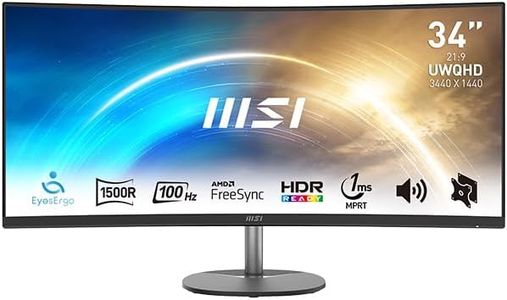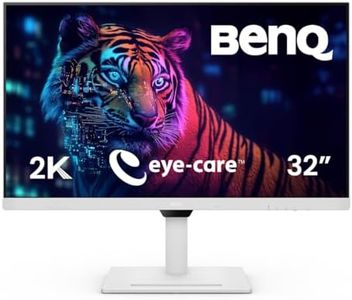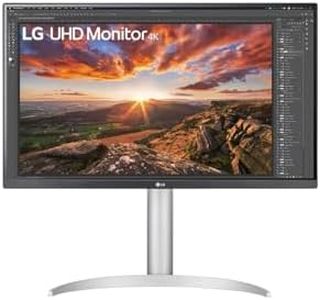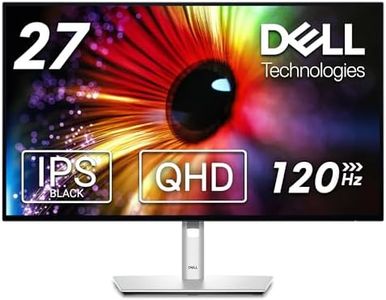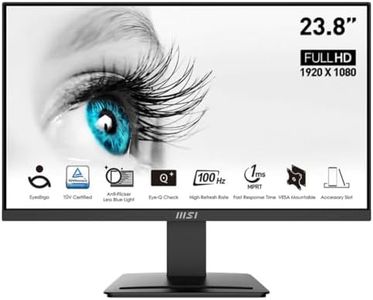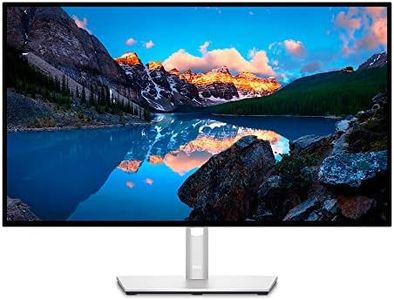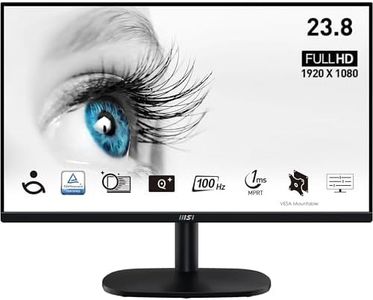We Use CookiesWe use cookies to enhance the security, performance,
functionality and for analytical and promotional activities. By continuing to browse this site you
are agreeing to our privacy policy
10 Best Monitors
From leading brands and best sellers available on the web.Buying Guide for the Best Monitors
Choosing the right monitor can really change your experience, whether you use it for work, gaming, or browsing the web. When picking a monitor, consider what you mostly do with your computer: editing photos, watching movies, playing games, or just doing everyday tasks. Each use case benefits from different features. By understanding a few key specs, you can find a monitor that best fits your needs and offers a comfortable and enjoyable viewing experience.Screen SizeScreen size is the diagonal measurement of your monitor, usually in inches. A larger screen gives you more space to multitask or enjoy movies, but also takes up more space on your desk. Smaller monitors (around 21–24 inches) work well for basic tasks and compact spaces, while medium (24–27 inches) is ideal for most home office and casual gaming setups. Large screens (28 inches and up) are great for multitasking or immersive viewing, but make sure you have the desk space and sit far enough away to avoid straining your eyes. Think about how close you'll sit to your desk and what tasks you do most to choose the right size.
ResolutionResolution is the number of pixels on the screen and determines how sharp and detailed images look. Common resolutions include Full HD (1920x1080), Quad HD (2560x1440), and 4K (3840x2160). Higher resolutions mean clearer visuals and more working space, especially on bigger screens. For basic use, Full HD is usually enough. If you want sharper detail for gaming or creative work, Quad HD or 4K are better—but keep in mind that higher resolution needs a more powerful computer to run smoothly, especially in games.
Refresh RateRefresh rate, measured in hertz (Hz), is how many times per second the image on the monitor updates. Higher refresh rates make motion look smoother. Most basic monitors have 60 Hz, which works for everyday use and watching videos. Gamers usually prefer 120 Hz or 144 Hz and above because it makes games look more responsive and reduces motion blur. If you mostly use your monitor for work or casual use, 60 Hz is fine, but if you play fast-paced games, consider a monitor with a higher refresh rate.
Panel TypePanel type refers to the technology behind the screen. The most common are IPS, TN, and VA. IPS panels offer good color and wide viewing angles, making them great for work, designing, or sharing your screen with others. TN panels have faster response times but less vibrant color, and are popular with competitive gamers. VA panels provide deep blacks and high contrast, which is great for watching movies in the dark. Consider what matters most to you: color accuracy and viewing angles, speed, or contrast.
Response TimeResponse time is how quickly a pixel can change from one color to another, usually measured in milliseconds (ms). Lower response times mean less motion blur in fast-moving scenes. Most people won't notice the difference for basic tasks, but fast response times (1–4 ms) are important for gamers or anyone who watches a lot of sports or action content. For general use, higher response times aren't an issue, but if you play a lot of fast games, a lower response time helps.
ConnectivityConnectivity is about the types and number of ports like HDMI, DisplayPort, USB-C, or even old VGA that your monitor has. The right ports make it easier to connect your devices like laptops, PCs, or game consoles. Make sure your monitor has enough and the right kind of ports that match your computer and other devices. If you plan to use multiple devices or need to charge devices from your monitor, look for USB-C or extra USB ports.
Ergonomics and AdjustabilityErgonomics refers to how easily you can adjust a monitor for comfortable use. Features like height adjustment, tilt, swivel, and pivot can help you set the screen at the right level and angle to avoid neck or back strain, important for those spending long hours at the desk. If you value comfort, especially for office work or prolonged use, look for a monitor with good adjustability options.
Color Accuracy and GamutColor accuracy is how true the monitor's colors are compared to real life. Color gamut means the range of colors the display can show. If you work with photos, videos, or design, a more accurate and wide color range is important—look for monitors advertised for good color accuracy or with high sRGB or Adobe RGB coverage. For everyday tasks, color accuracy isn’t as critical, but if creativity or visual work is your main use, prioritize these features.
